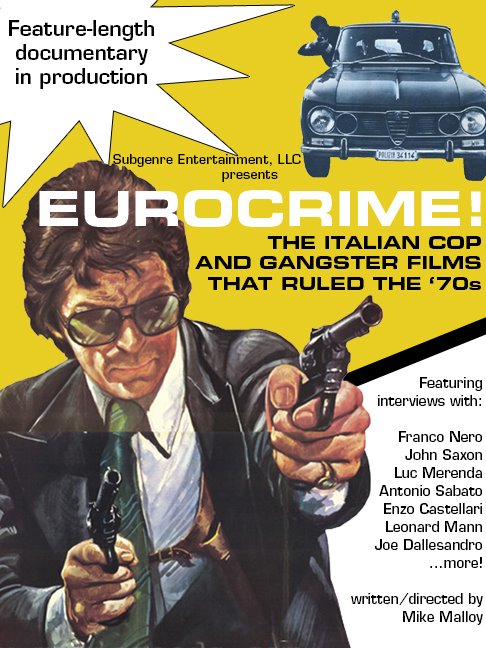Mike Malloy is an Atlanta-based screenwriter, actor, and director. While in college he wrote and published a book on Lee Van Cleef. He’s a true aficionado of 1970s tough-guy cinema, Spaghetti Westerns, the little-known films directed by David Carradine, and much more. His documentary, EUROCRIME!, has been included in numerous film festivals and was recently written about in Maxim magazine.
This interview was originally published in PulpMetal magazine, an online zine that I write for now and again.
(Photo below: Mike Malloy in tough-guy mode.)



MDJ : Mike, you’re involved in the production of both docs and feature films, all with, I think, somewhat of a retro quality — as in your look back at Eurocrime films of the 1970s (EUROCRIME!) and the neo-Spaghetti western you helped make (THE SCARLET WORM). What factors go into your choices of the material for films you are making?

MM : I guess the more direct link to Spaghetti Westerns would be the official DJANGO sequel I co-wrote. In the case of THE SCARLET WORM, we wanted to make a film in the style of the American Revisionist Westerns of the early ’70s, like Fonda’s THE HIRED HAND or Peckinpah’s PAT GARRETT AND BILLY THE KID. Perhaps the insane microbudget kept that from shining through to some viewers. Or maybe the fact that four SCARLET actors had been Spaghetti Western veterans became a distraction to our intended tone.
But basically my interests are tough-guy subjects, usually of the middle-aged variety, as guys of that age naturally have more life experience. The retro quality is almost just a side effect; the 1970s happen to have been a golden age for credible movie tough guys.
MDJ : I too like tough-guy action films. Speaking very generally, about the time that there was a revival of the tough guy in film, there was also a revival of classic American hard-boiled detective fiction — the work of Hammett, Chandler, and, a little later, Jim Thompson. Some attribute that to a sort of collective desire for strong heroic male figures who would battle corruption in society at all levels, from government (where Watergate and the war in Vietnam had created a sense of distrust of government) to organized crime to crazy serial killers, etc etc. What do you think caused the rise in appeal of the tough-guy hero in the sixties and seventies?
MM : There have always been action and tough-guy films and novels; it’s just a matter of which ones endure to become a classic period for such. I think the larger shift toward realism in American popular cinema in the late ’60s / early ’70s helped that period’s tough-guy movies, because non-glamorous fellas like Warren Oates, Lee Marvin and Charles Bronson could headline movies instead of pretty boys. Also, the timing with World War II meant you had some battle-hardened vets starring in movies. Marvin and Bronson both were. Lee Van Cleef too.
MDJ : On the other hand, revisionist Westerns questioned the idea of a hero and questioned the glorification of the “conquest” of the American West. It seemed to raise questions about the morality of some of the actions that the tough guy takes. Thoughts on this aspect of the film genres that appeal to you?

MM : That trend started in a more subtle way in the 1950s with the “adult Westerns” (the term they used then; nothing to do with smut). Films like HIGH NOON and THE TIN STAR were provocative, complex movies that didn’t just present white-hat / black-hat visions. But yeah, the morality was even more subjective by the time we got to the revisionist Westerns of the late ’60s.

(Above: Mike Malloy in a film he helped produce, THE SCARLET WORM.)
It’s interesting you should ask this, because I think a big ill of the current cinema is envelope pushing for the sake of envelope pushing. In tough-guy cinema, The Antihero is being pushed farther and farther, in a cheap tactic to seem fresh and on the vanguard. So I wrote a screenplay, LETTER OF THE LAW, that attempts to re-set things with a character that is purely heroic (and yet not a goody two-shoes). I came up with a novel, concept-driven action plot to accomplish this. It’s been optioned now, and I’m excited.

MDJ : How did you get the film optioned? Did an agent send it out for you or was it sent to a producer you knew or a friend of yours knows? Related to this, what is the spec script market like for feature films? I had the impression it had dried up and money from small indie features in terms of sales was small — you yourself said this to me — hard to make any money on the smaller, indie film! So who is buying? Or have Red Box, Netflix, VOD taken off now?
MM : This script was optioned because of some existing relationships. And yes, the spec-script market is very tough, because everyone fancies him/herself a writer, so most filmmakers and producers aren’t soliciting scripts; they have one of their own!
But all that’s almost irrespective of your other question. Yes, the middle class of film has almost evaporated, dichotimizing to either exploding-robot movies being made for $80M+ or microbudget $40k indies. Everything in-between is, sadly, dicey. Fortunately, one of the producers of LETTER OF THE LAW teaches film business, and we’ve identified a release model and a budget that will actually work for this project and for investors.
MDJ : At one time tentpoles were what lifted a whole tent. Now it’s a kind of movie. I remember a 2013 CNN interview in which Peter Bogdanovich bemoaned the success of TITANIC, as it led to $150M and $200M budgets.
Maybe TITANIC was a turning point where blockbuster budgets got soooo disproportionate and everything became soooo VFX reliant, but the blockbuster mentality really began in the latter half of the ’70s, of course, with JAWS, STAR WARS, SUPERMAN, etc. And we’ve been stuck in that blockbuster mode ever since, excepting the brief hiccup of the ’90s indie boom. People say the film business is cyclical. Well, we’re damned overdue for this cycle of noisy exploding-robot movies to end.
MDJ : So, the real question is, does anyone making microbudget films make a living or even prosper? What percentage do you think? You know a lot of those people — and you are one yourself!

MM : It’s probably a 1/1000 shot whether you’ll see a little scratch. Most microbudget filmmakers basically give their projects away for no Minimum Guarantee (MG), or advance. And if you sign a royalty-only deal for your film … well, you know what they say: If you want to know what to expect on a royalty deal, spend a day in a communal prison shower.
We all need to make fewer, better films, peoples! One film every three years instead of three every one. And let’s not give them away. We’re junking up the pop-culture landscape with too much disposable product.
MDJ : What advice do you have for aspiring micro-budget filmmakers?
MM : Don’t make a film out of opportunity. Make a film only if you have an idea burning inside you, compelling itself to be produced.
Recently, on the set of SAMURAI COP 2, I overheard a conversation between two filmmakers. One said, “Don’t make your passion project first. You’ve got to make a sell-out project first, and then you can make your passion project.” I bit my tongue, but I wanted to say, “If people only made their passion projects, then there’d be no problem. The market wouldn’t be overly crowded, and there would be less difficulty selling a film. And the films in the marketplace would be a helluva lot more interesting and personal.” So let’s skip the sell-out projects altogether, peoples!
MDJ : What about cable? Anything happening there or has that vanished as a market?
MM : Well, microbudget stuff, if that’s what you’re asking about, is much more likely to end up on VOD / streaming these days.

But cable telly is in a new golden age, with all of the “prestige soaps” like DEADWOOD and MAD MEN and RAY DONOVAN that followed in the wake of THE SOPRANOS. And occasionally a show like THE WIRE will transcend the soapy nature of these shows and become something truly important. So cable telly is where a lot of great work is being done today.
MDJ : Please talk about your involvement with the magazine CULT MOVIES. And how might that have shaped your current work?
MM : I was on the editorial staff of the quarterly mag CULT MOVIES when I lived in Los Angeles, ’01-’04. And even though my primary interests were gritty tough-guy cinema, I copyedited all sorts of articles, about all sorts of cult films. I may have been writing about ACROSS 110th STREET, but I was copyediting someone else’s piece on SHRIEK OF THE MUTILATED. And through the mag, I had dinner with such varied personages as Ray Bradbury, Forry Ackerman and Bob Chinn. So working there certainly broadened my knowledge base past my scope of interest.

